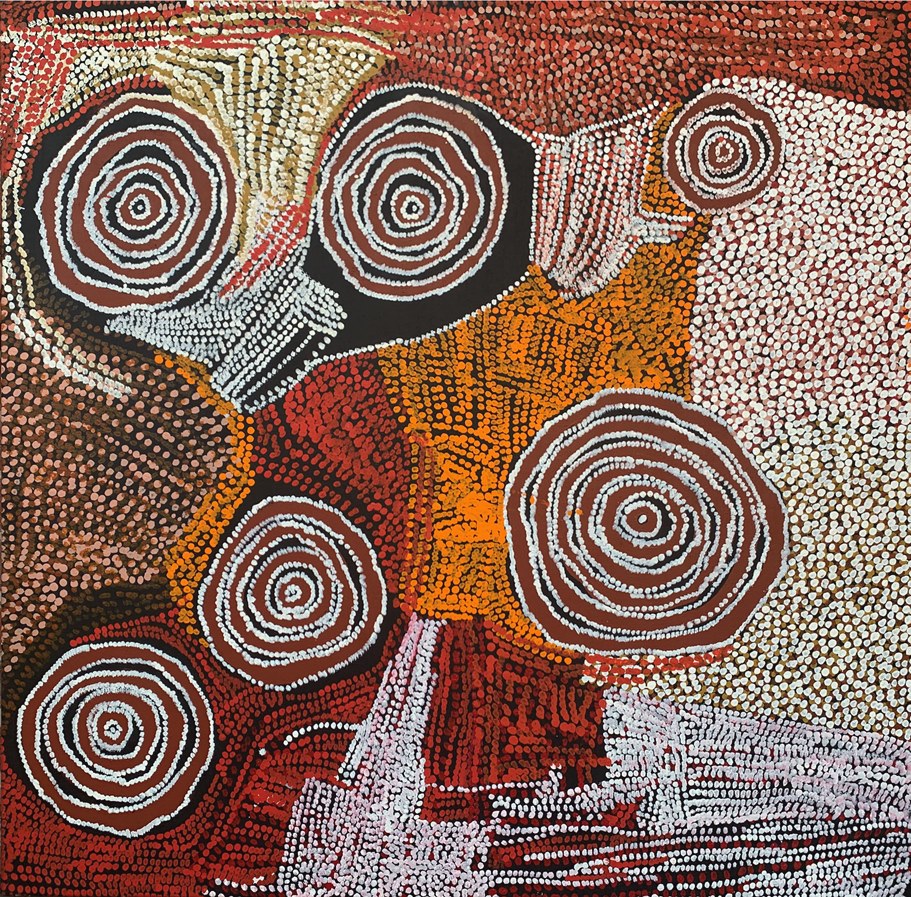Dr George Ward Tjapaltjarri & Ngangkari Artists
Dr George Ward Tjapaltjarri is one of Australia's pre-eminent Aboriginal artists, with his works collected by the National Gallery of Australia, the National Gallery of Victoria and international galleries in the Netherlands and the USA. One of the original group of Papunya artists, he was revered as a ngangkari, a medicine man, or ‘clever’ man, possessing exceptional knowledge and healing skills. In this article we profile Dr George and other important senior Ngangkari artists.
Feature Image Top Right: Dr George Tjapaltjarri | Malliera Ceremonies | Jap 019915
About Dr George Ward Tjapaltjarri
Date of Birth
c. 1930 - 2017
Place of Birth
Puntujarrpa, near Jupiter Well
Language
Pintupi, Pitjantjatjara
Communities
Kintore, Kiwirrkurra, Tjukurla
Family
George’s older brother, Tommy Lowry Tjapaltjarri, was one of the original Papunya Tula shareholders. Dr George’s membership to this small, elite group of artists which triggered the Central Australian Art Movement and soon gained him international recognition. Dr George first painted a couple of small paintings in Papunya in 1971 and then also painted for Papunya Tula Artists in the mid to late 1970s. He returned to painting in the late 1980s, first for Papunya Tula and then for Gallery Gondwana and occasional other private dealers as an independent artist, achieving recognition for his bold, scaled-up designs.
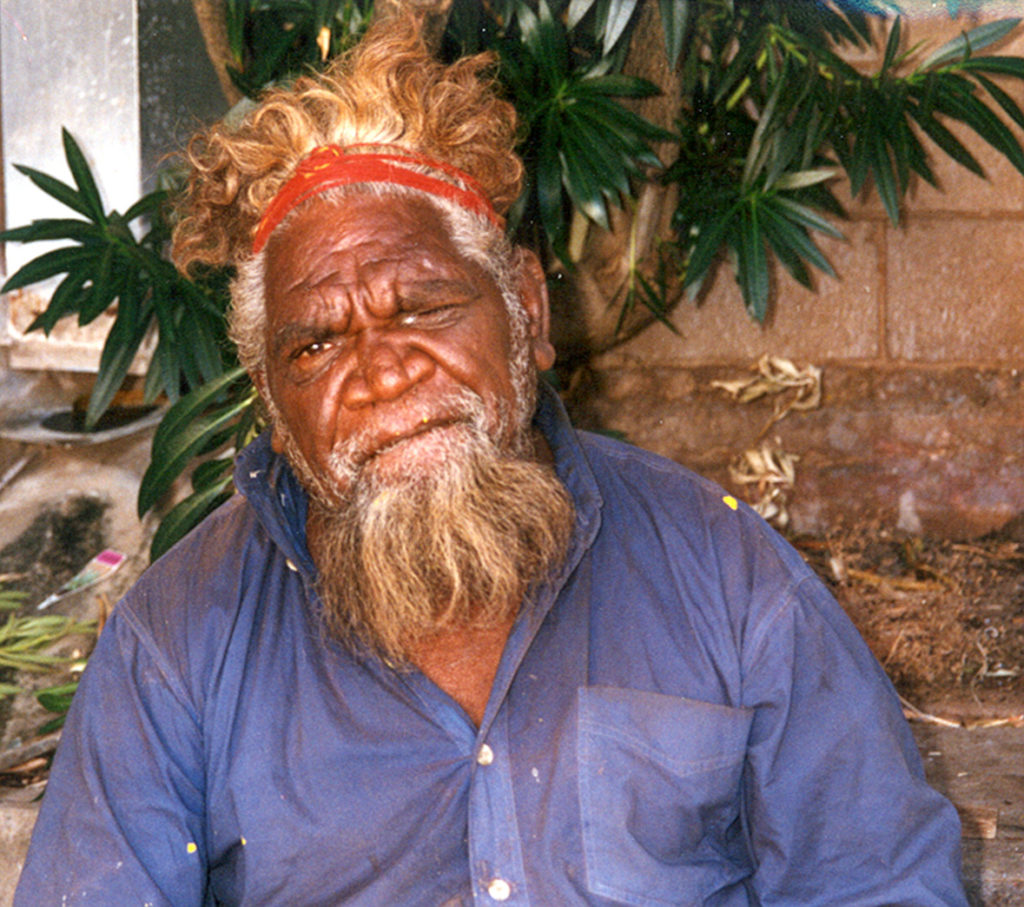
Personal History
Dr George Ward Tjapaltjarri, also known as Nyunmul, Nyunmul-nga as well as Takata and Takara, was born south west of Puntujarrpa (Jupiter Well) in the Gibson Desert in Western Australia. Nyunmul, or Dr George as he became known, was the son of Yawarla Nangala and her husband Pitjunpitjuri Tjungurrayi. His traditional country includes Karrinyarra west of Kintore and Kilinya in Winanpa territory west of Puntujarrpa, and in pre-contact days he had travelled as far east as the Pollock Hills.
First Contact
Dr George came out of the desert in April 1964, as part of a small group of Pintupi people living near Jupiter Well (Puntujarrpa), 900 kms west of Alice Springs. He was well into his thirties at this time and had been living a lifestyle that dated back many thousands of years. This deep traditional cultural knowledge later found expression in his art. Anthropologist, Jeremy Long, remembered him in at this time as a “youngish bachelor, very lively and extroverted. He was the sort of person who was really keen to see the world - like Nosepeg and Charlie Tarawa in the previous generation."
Medicine Man
Dr George was also revered as a ngankari, a medicine man, or ‘clever’ man, possessing exceptional knowledge and healing skills, hence the name, Dr George, was assigned to him as a mark of deep respect. He was an extraordinary man, for as well as using his traditional healing skills, he had a great history of helping desert people assimilate and feel comfortable with western medicine and a new environment.
After the Pintupi move to Kintore, Dr George was one of several Aboriginal doctors, ngangkari, attached to the Kintore Health Clinic. As a ‘doctor man’, his powers and skills in traditional healing were legendary. Dr George spoke very little English and had no particular desire to learn. His interests lay more in imparting his extensive knowledge of the environment, nature, bush crafts and traditional healing to his community and to other interested parties. This knowledge was regarded with awe. Dr George also worked in the same capacity as he did at Kintore, for the Tjukurla Medical Clinic, and was often employed by Central Australian Aboriginal medical units to perform traditional medicine.
Traditional Ceremonies
As an important Pintupi elder, Dr George was also responsible for initiating young men into law. During these important traditional men’s initiation ceremonies, malliera, secret and sacred by nature, Dr George revealed to initiates not only the knowledge connected to the Tingari cycle but also the related sacred sites located in his own traditional country. This knowledge is expressed in the ceremonial body paint designs which indicate a strong, personal association with the desert landscape, its land formations of water soakages, creek beds and sandhills, all connected to the Ancestral Creation Beings.
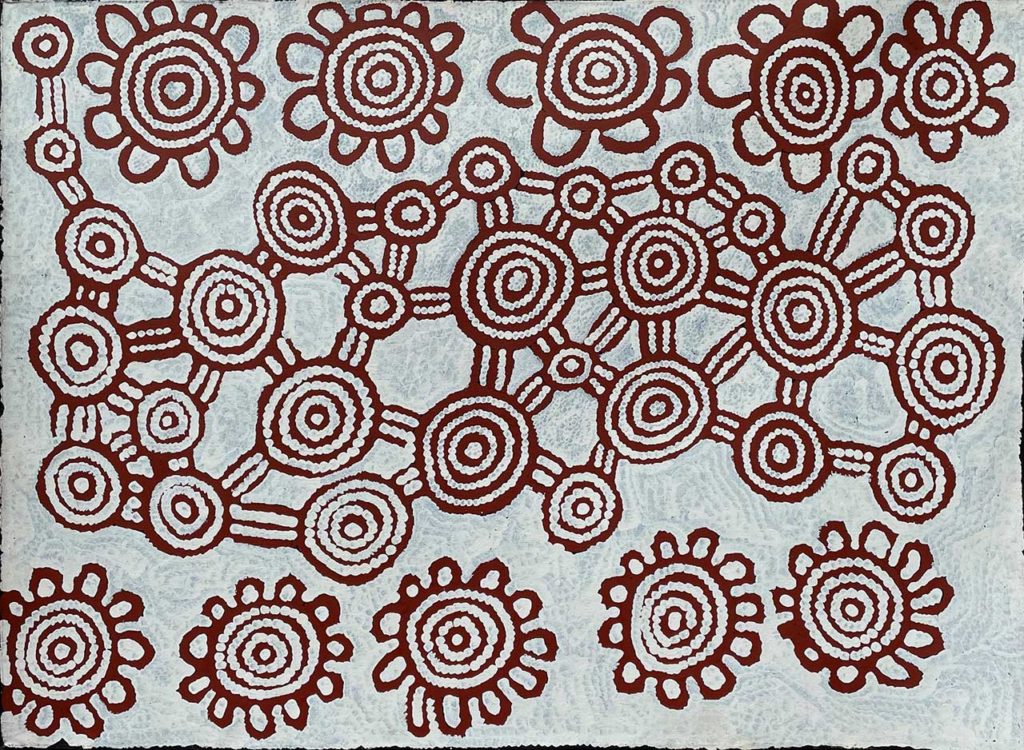
Passing On Of Knowledge
The last of Dr George’s four children, Maisie Ward Nungurrayi, was born in Papunya around 1975. When she was still young, she moved to Kintore with her family and spent her school years there. Her mother passed away when she was sixteen. In his final years, Dr George lived in Docker River at the Aged Care Centre. Maisie said of him in those years, “He’s crippled and mostly blind, but he still talks to you and he knows who is coming, even though he can’t see them. As a Ngangkari, he goes everywhere at night time, travels. He says, ‘I was there - in your sleep.’ He started painting after my mother died, painting in Alice Springs. My father told me to do the painting – his country. He taught me Ngangkari, gave me some of that knowledge, sit down at night time. I’ve been fixing a lot of people... Tingari, one from father’s country – Junti – I can paint it. Songs, I know. I got the Song. Big culture there. Big culture for everybody, at Kiwirrkura - not in the place Kiwirrkura, but out in the bush. A lot of women were there for big culture meeting, a couple of years ago (maybe 2012). I used to work for Women’s Congress. Languages – Luritja from my mother’s side and Ngaanyatjarra from my father’s side. We travelled a lot from Kintore to Docker River. I’ve been visiting family, my father’s family, all over – Warburton, Punmu, Well 33.” In this traditional way, Dr George’s deep knowledge, both as a healer and an artist, is being carried on into the future.
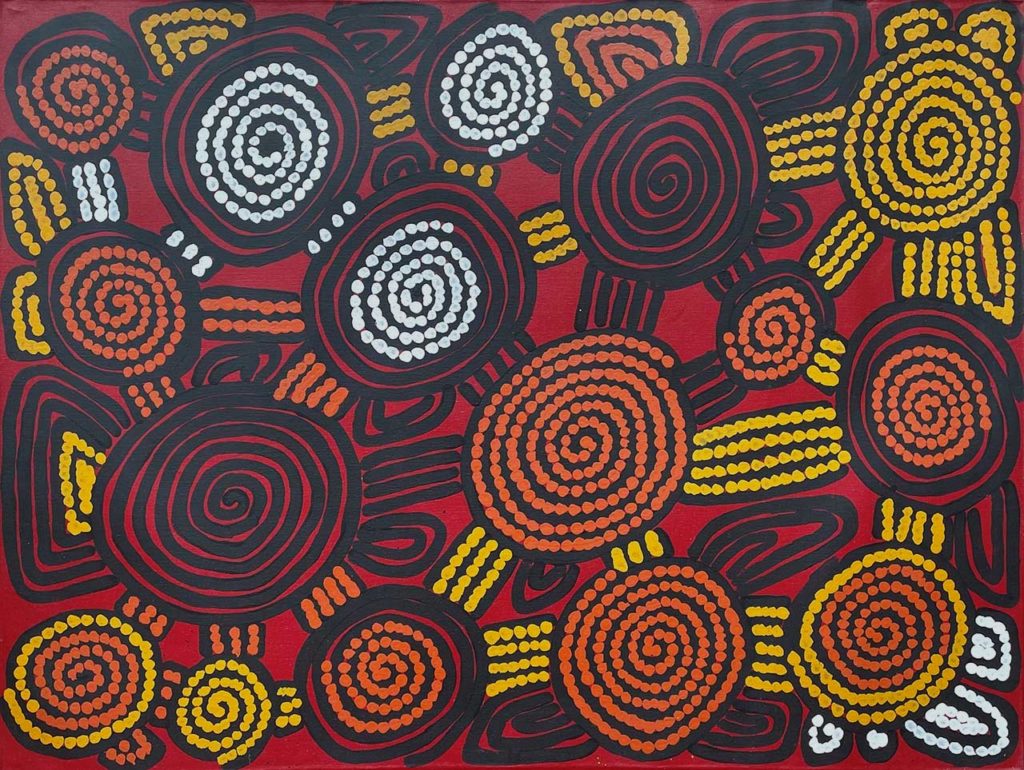
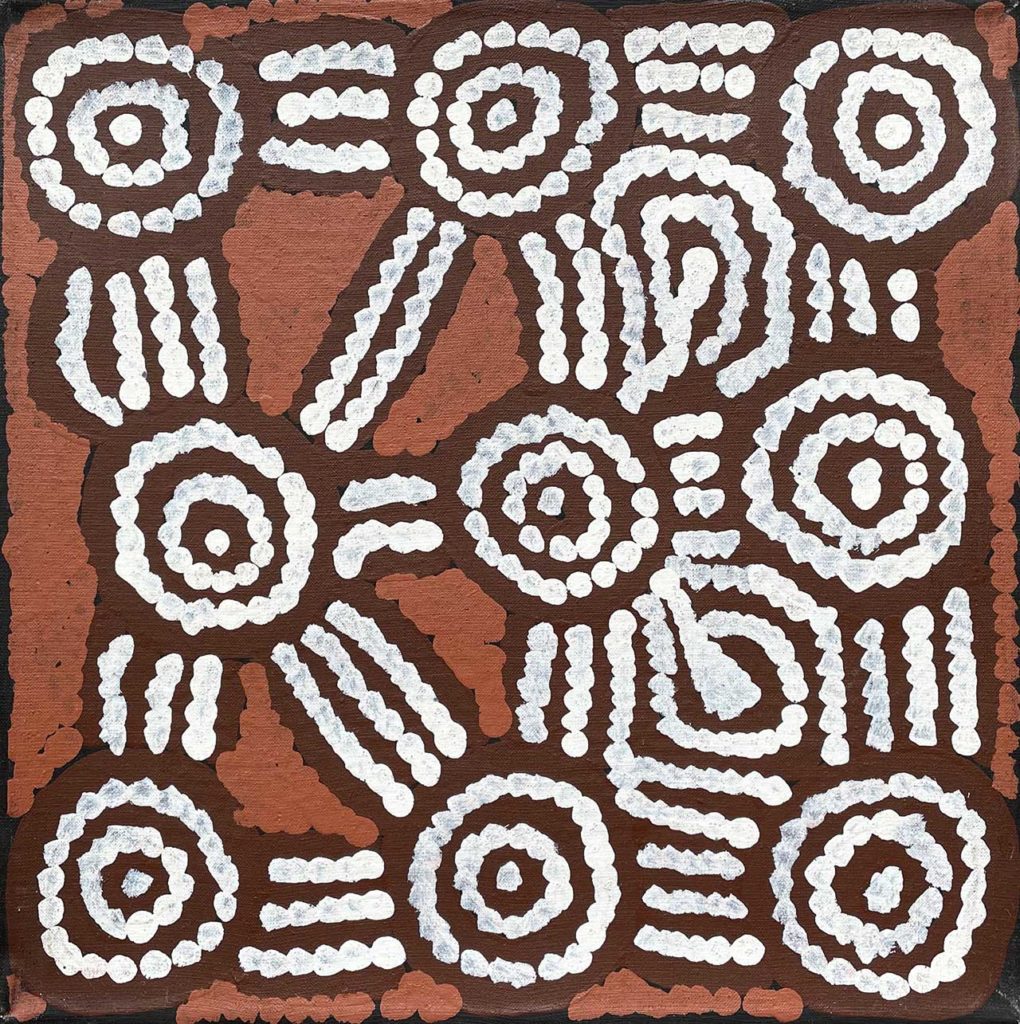
Interview with Dr George Tjapaltjarri
Courtesy of Gondwana Gallery, read a rare interview transcript with Dr George Tjapaltjarri, arranged in Alice Springs in the late 1990's. Through a translator, Dr George talks about many topics including:
- his birthplace
- first contact with white people
- underground water sources
- traditional foods
- his traditional painting (different from the 'European' style painting he later practised)
- becoming a traditional healer
- coming to Papunya and the early days of the contemporary Aboriginal Art movement
The interview gives a fascinating insight into his world as well as the genuine interest of the interviewers who were keen to learn more about his life and culture. It is a rewarding 15 minute read and an important part of Australia's oral history.
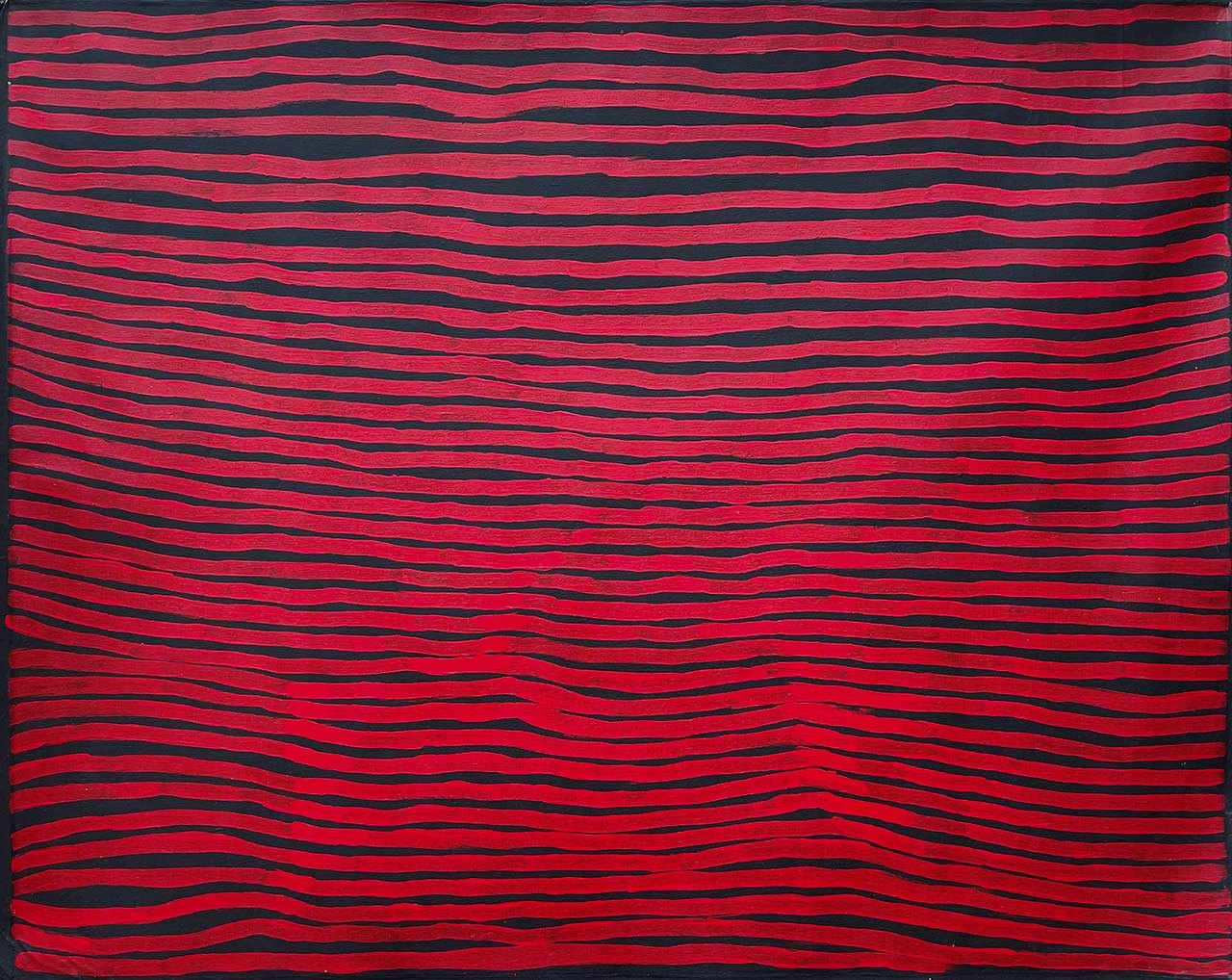

"Boards by Dr. George feature in the original Tjungunutja collection. He was painting in 1972 and 1973. In the book, associated with that exhibition, you’ll see a big image of Dr. George demonstrating spear throwing in 1973. He was a fantastic spear thrower as well as being a great hunter. You’ll also see photos of him in this book doing body paint designs. Right at the beginning of the contemporary Aboriginal art movement he was painting significant cultural stories."
Interview with Roslyn Premont, Gallery Gondwana
Interview: Roslyn Premont - Dr George Tjapaltjarri: Ngangkari - Clever Man
Dr George Ward Tjapaltjarri’s paintings possess a wonderful rawness and boldness, conveying his strong, continuous association with his traditional country, ceremonies and the application of body paint designs.
"He was one of the first Aboriginal men to paint outside of traditional cultural context. He was one of the elders right at the beginning when a group of elders painted the boards at Papunya in the early 1970's. The museum in Darwin (now the Museum and Art Gallery of the Northern Territory), did a fantastic show featuring many of those little boards. The exhibition was called Tjungunutja, from having come together. These were the very first boards that were painted and purchased. The museum were the first to recognise their value and gather together that early artwork. They could not have guessed at the time that they were documenting the birth of the contemporary Aborignal art movement."
Roslyn Premont, Director, Gallery Gondwana, Alice Springs
Read: Interview: Roslyn Premont - Dr George Tjapaltjarri: Ngangkari - Clever Man
Dr George Ward Tjapaltjarri - About His Artistic Career
Solo Exhibitions
1998 Dr George Tjapaltjarri, Gallery Gondwana, Alice Springs NT
2022 Dr George Tjapaltjarri: Nangkari – Clever Man, Japingka Gallery, Fremantle WA
Selected Group Exhibitions
1988 Queensland Museum, Brisbane QLD
1988 Tingari – My Dreaming, Japingka Gallery, Fremantle, Perth WA
1988 Tingari Cycle – Paintings of the Pintupi, Gallery Gondwana, Alice Springs NT
1988 Walimpirrnga Tjapaltjarri & Dr George Tjapaltjarri, Coo-ee Aboriginal Art Gallery, Sydney NSW
1989 Mythscapes, National Gallery of Victoria, Melbourne VIC
1990 Araluen Art Centre, Alice Springs NT
1992 Dreamtime Gallery, Broadbeach QLD
1993 Chapman Gallery, Canberra ACT
1999 Painting the Desert, Alliance Francaise de Canberra & French Embassy, Canberra ACT
1999 Tingari Cycle, FireWorks Gallery, Brisbane QLD
2000 Landmarks, Brisbane Powerhouse, Dar Festival, Brisbane QLD
2000 Recent Paintings by Walala Tjapaltjarri & Dr George Tjapaltjarri, Coo-ee Aboriginal Art Gallery,
Sydney NSW
2000 Lines, FireWorks Gallery, Bowen Hills, Brisbane QLD
2000 From Utopia to Kintore, Melbourne VIC
2000 Country after Rain, Framed Gallery, Darwin NT
2001 Alliance Francaise de Canberra & French Embassy, Canberra ACT
2002 Mine, Gallery Gondwana, Alice Springs NT
2003 Redrock Gallery, Melbourne VIC
2004 Redrock Gallery, Melbourne VIC
2005 Redrock Gallery, Melbourne VIC
2006 Redrock Gallery, Melbourne VIC
2007 Redrock Gallery, Grand Opening, Beijing, PR China
2007 Redrock Gallery, Grand Opening, Beijing, PR China
2007 Redrock Gallery, China World Exhibition Centre, Beijing, PR China
2007 Redrock Gallery, Grand Hyatt Hotel, Beijing, PR China
2007 Redrock Gallery, International Art Expo, Beijing, PR China
Collections
Artbank Australia
Kaplan Levi Collection, Seattle WA USA
Mem Ziz Collection, Melbourne VIC
Museums and Art Galleries of the Northern Territory, Darwin NT
National Gallery of Australia, Canberra ACT
National Gallery of Victoria, Melbourne VIC
Holmes á Court Collection, Perth WA
Supreme Court of the Northern Territory, Darwin NT
Vroom Collection, THE NETHERLANDS
Fondation Burkhardt-Felder Arts et Culture, Motiers SWITZERLAND
References
Hood Museum of Art - Dartmouth
View
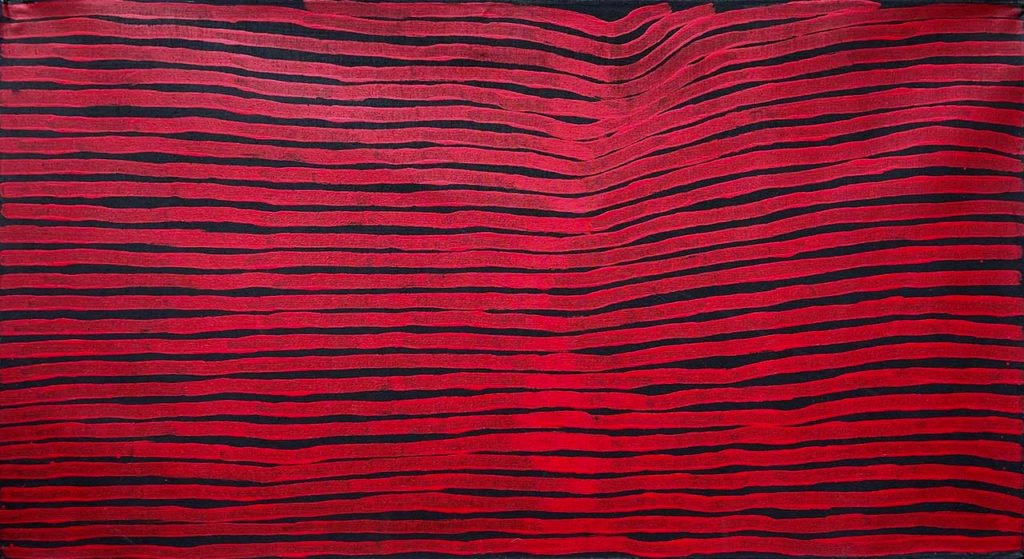
Other Ngangkari Artists
Aboriginal Men and Women of High Degree
Ngangkari, or medicine men and women, have nurtured the physical, emotional and social wellbeing of their people for thousands of years. The term ngangkari applies to traditional healers of the Anangu, who live mostly in the APY Lands, which encompass about 103,000 square kilometres (40,000 square miles) of South Australia and include the Western Desert Cultural Bloc of Aboriginal peoples. It is also the term used by Pintupi/Luritja people. The variant spelling, ngangkere, is used in the Arrernte languages, while in much of Western Australia the words Maparn and Maparri are terms used for traditional healers. In Yolŋu law, Madayin, of Arnhemland, authorized traditional healers and doctors are called Marrŋgiyj. Many of these remarkable doctors, steeped in the deepest knowledge of their culture, have also been renowned artists, including these mentioned below.
Helicopter Tjungurrayi (1947 - )
Kukaja artist Helicopter Tjungurrayi is from Balgo Hills in Western Australia was born at Nynmi in 1947), Helicopter, who learnt from a young age the vital location of water sources and how to hunt for bush food, is a highly esteemed maparri, traditional medicine man, and people travel hundreds of miles to see him for healing. He is also a respected painter, alongside his wife Lucy Yukenbarri. In the early 1990s he painted with his wife, not seeking any acknowledgement. Helicopter paints his mother’s country, Piparr; his father’s country, Nynmi; The Tingari Cycle and Soak Waters.
Bill Whiskey Tjapaltarri (c.1920 - 2008)
The great, late Pitjantjatjara artist, Bill Whiskey Tjapaltjarri was a “big business” man in his community - a ngangkari, or traditional healer, and people came from afar to be treated by him. His widow, Colleen, is also a highly respected ngangkari, as is one of their sons, Herbert. Whiskey began painting in 2005. The main images in his works are the Rockholes near Pirupa, to the west of Ayers Rock, and the story of his journeys to Areyonga and Haasts Bluff. Whiskey was a highly traditional man with an extremely jovial personality. The bold colours evident in many of his works are said to reflect Bill Whiskey’s character – colourful and strong in spirit. His paintings quickly became among the most sought-after indigenous works in Australia and overseas. He only painted for the last three years of his life, after retiring as a ngangkari, and instantly gained international recognition as an artist.
Betty Muffler (1944 - )
Betty Muffler was born in 1944 in country near Watarrunea, near the border of South Australia and Western Australia. She lives and works in Indulkana Community on the Anangu Pitjantjatjara Yankunytjatjara (APY) Lands in remote north-west of South Australia.
Betty is a renowned ngangkari, traditional healer, and senior cultural woman. As a young woman Betty decided to walk the long distance from Ernabella to Maralinga to visit her extended family, whom she had not seen for a long time. However, at the beginning of her journey, she met some missionaries who told her of the bomb testing in that area, and that it was dangerous to continue in that direction. So she travelled with them to the Granite Downs cattle station on the back of a donkey.
“The smoke was coming from the bomb, so I came to Granite Downs instead. Those missionaries knew it was dangerous, so we came riding altogether on white donkeys to Granite Downs.”
Throughout her twenty’s, Betty lived with her two paternal aunties, sisters to her father, at the Granite Downs station. These two women taught Betty the skills of ngangkari, traditional healing, which became a life-long practice. Her father had also been a recognised and respected ngangkari, and he had begun to teach her these skills when she was young, until his untimely death.
Betty continued to practice ngangkari while at the Granite Downs Station and, when she married, she moved to the newly established Indulkana community where she spent many years working at the clinic as a ngangkari. She has healed many sick friends and family members directly in their own homes, and was invaluable for the doctors and nurses who practiced in the first clinics on the APY Lands. Betty is still called upon regularly to perform her healing practices.
“Back then that doctor used to come and get me from the wiltja at the river, and take me to the clinic. They knew I was a good ngangkari, and would come get me in case sick people wanted me at the clinic. Before the clinic was there, the nuns used to help sick people in the bush; they would send them people away to hospital if they were sick. But ngangkaris can see right through people to what sickness is inside. Then they can heal them straight away.”
One practice of ngangkari is to travel on spiritual journeys called marali, where the ngangkari’s spirit rises up out of the sleeping person’s physical body, and travels alone, or with other ngangkari, on healing and educational journeys. Betty has special mapanpa, sacred tools that are gifted to ngangkaris early in their career and stay living inside them, such as in the palm of their hand.
"This is my country, this is ngangkari country - it's healing, it's good. I've travelled everywhere on the APY Lands, sometimes during Marali (spiritual ngangkari travelling) and sometimes just to visit friends. I'm a strong kungka (woman) I survived the bombings at Maralinga, but many of my family didn't. It's a terrible and sad story. We need to heal this country, and give more respect to the land. My painting shows many of the good places in my country.
I am a Ngangkari, I've got an eagle’s spirit so I can stay at home here and in my sleep I send my eagle spirit across the desert to look for sick people, then I land next to them and make them better. Ngangkari's can see right through people to what sickness is inside, then they can heal them straight away."
Alongside a rigorous art practice, Betty continued to work extensively with NPY Women's Council and medical practitioners to support Anangu to good health and through times of crisis. Betty is now retired and works at home where she makes beautiful baskets. Only a few years ago was she persuaded to try painting. At first, she painted her tjanpi baskets but she now enjoys painting with bold colours and strong designs. She paints rockholes and creeks, the sandhills and wildflowers. Betty Muffler won the 2017 NATSIAA Award for an emerging artist, her paintings have been exhibited extensively, and her work is held in significant collections throughout Australia and internationally.
